- Kids Preschool
- About Blocks ( 막기 makgi )
- Supported Hand Blade Outward Block ( 손날 거들어 바깥막기 sonnal-kodureo-makgi )
Taekwondo 태권도Taekwondo Preschool
Promotion from one geup to the next can proceed rapidly in some schools, since schools often allow geup promotions every two, three, or four months. Students of geup rank learn the most basic techniques first, and then move on to more advanced techniques as they approach first dan. Many of the older and more traditional schools often take longer to allow students to test for higher ranks than newer, more contemporary schools, as they may not have the required testing intervals. View Taekwondo belt levels »

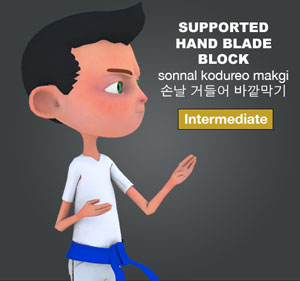
Supported Hand Blade Outward Block
( 손날 거들어 바깥막기 sonnal-kodureo-makgi )
Difficulty Level: Intermediate Technique: Blocks ( 막기 makgi )
In the Supported Hand Blade Outward Block ( 손날 거들어 바깥막기 sonnal-kodureo-makgi ), the lead hand ( 손 son ) is kept in a knife hand ( 손날 sonnal ) posture to block ( 막기 makgi ) attacks to the torso while the rear hand (also in knife hand posture) could be used as a counter strike.
The blocking hand starts from shoulder level with the palm ( 손바닥 sonbadak ) up while you stretch the other hand far from the waist with the palm ( 손바닥 sonbadak ) facing downward at shoulder height level. Both hands come across the body, intersecting at the forearms and providing a firm defense blocking the attack. Also with both hands held out open in the knife hand ( 손날 sonnal ) posture, a kick ( 차기 chagi ) aimed at the solar plexus can be successfully blocked.
In the final form of Supported Hand Blade Outward Block ( 손날 거들어 바깥막기 sonnal-kodureo-makgi ), the blocking arm's elbow ( 팔굽 palgup ) and the supporting hand should not be touching each other. Remember to keep the wrists ( 팔목 palmok ) straight and the blocking arm is angled at approximately 90-120 degrees. The supporting hand could be used as a counter strike such as the Palm Heel Forward Strike ( 바탕손 앞치기 batangson-ap-chigi ), Spearhand Vertical Thrust ( 편손끝 세워찌르기 pyeonsonkkeut-sewo-jjireugi ), or the Flat Fingertips Horizontal Strike ( 편손끝 엎어찌르기 pyeonsonkkeut-eopeo-jjireugi ).
The knife hand ( 손날 sonnal ) is used often as both an offensive and defensive technique which can be executed as a high, low, middle, side, inward, outward, rising or circular. Use of this technique as a block ( 막기 makgi ) is featured prominently in many of the World Taekwondo (WT) Poomse. Taekwondo poomse are the learning ground for real combat. As such, every technique must display the requisite speed, power and firmness to be realistically used as an attack or defense move.
* Please see a certified Master Instructor ( 사범님 sabeomnim ) for training. Proper guidance and instructions are needed to ensure safe training.
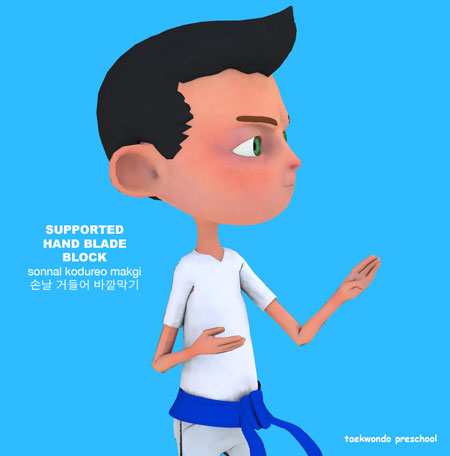
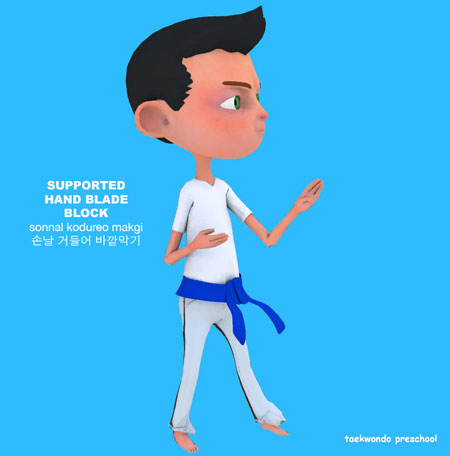
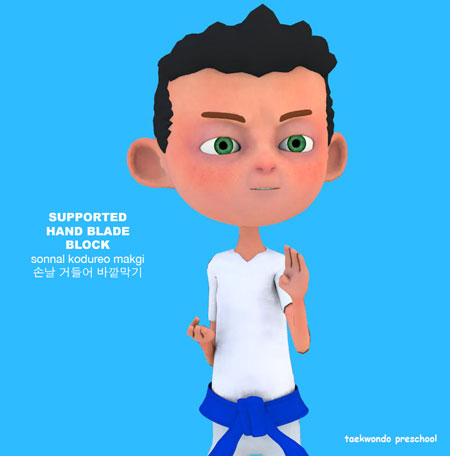

Did you know?
Taekwondo Summer Olympic Games

Taekwondo became a full medal sport at the 2000 Summer Olympics in Sydney, Australia, and has been a sport in the Olympic games since then. For Olympic competition, there will be a single elimination tournament for each of the weight categories. Repechage competition will occur for the bronze medal contest, while the winner of the tournament will receive the gold medal, and the loser will receive the silver medal. For more information View Taekwondo Summer Olympic Games »
| Year | Date | Flag | City | Host Country |
| 2020 |  |
Tokyo | Japan | |
| 2016 | August 5 -August 21 |  |
Rio de Janeiro | Brazil |
| 2012 | July 27 - August 12 |  |
London | United Kingdom |
| 2008 | August 8 - August 24 |  |
Beijing | China |
| 2004 | August 13 - August 29 |  |
Athens | Greece |
| 2000 | September 15 - October 1 |  |
Sydney | Australia |
RESOURCES
This article uses material from the Wikipedia article "Taekwondo at the Summer Olympics" which is released under the Creative Commons Attribution-Share-Alike License 3.0.

Quiz
Question. What is the korean terminology for Attention Stance?
Attention is a stance ( 서기 sogi ) where your body is in an upright standing position with the legs side by side, heels touching, distribute 50/50 weight ratio on the left and right legs, and toes facing straight forward. Your hands should be parallel with your body, to the side as your hands tap the legs.
What is the korean terminology for Attention Stance?
Answer you gave was: ( 그만 keu-man )
Your answer is wrong! You need to study more!
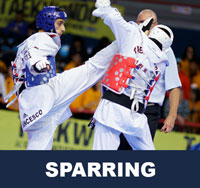

Keu-man ( 그만 ) means to stop a sparring match or poomse. Sparring is a full-contact event and takes place between two competitors in an area measuring 8 meters square. A poomse or form is a detailed pattern of defense-and-attack motions and techniques used in traditional martial arts. Poomse is the foundation for the teaching of taekwondo.
View Korean Terminology »
What is the korean terminology for Attention Stance?
Answer you gave was: ( 차렷 charyeot )
Your answer is correct! Great Job!
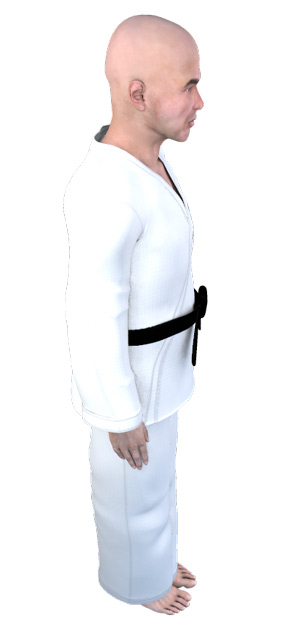

Attention is a stance where your body is in an upright standing position with the legs side by side, heels touching, toes facing straight forward. From this stance instructors explain what will be taught during the class session and/or if they want your attention they say Charyeot, meaning you stop whatever you are doing and get into the stance awaiting further instructions. This is the stance ( 서기 sogi ) that all bows ( 경례 gyeong-nye ) come from and is one of the most basic techniques to learn when starting taekwondo as a beginner.
What is the korean terminology for Attention Stance?
Answer you gave was: ( 기합 kihap )
Your answer is wrong! You need to study more!
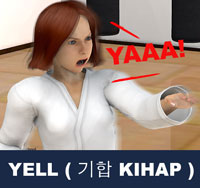

Kihap 기합 is a korean term used in taekwondo which is commonly referred to as a shout or yell made before, during, or after a technique. There are numerous examples of this battle cry in other martial arts: kihap is perhaps primarily a development of this. Students also use kihap to startle an opponent, intimidate, express confidence, or express victory in sparring competitions, self-defense ( 호신술 hosinsool ), or breaking ( 격파 gyeokpa ) applications.
View Yell ( 기합 kihap ) »
What is the korean terminology for Attention Stance?
Answer you gave was: ( 경례 gyeong-nye )
Your answer is wrong! You need to study more!
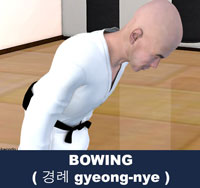

Bowing ( 경례 gyeong-nye ) is the act of lowering the torso and head as a gesture in direction to another person (Master Instructor 사범님 sabeomnim ) or symbol (flag). Bowing is an integral part of traditional martial arts such as Taekwondo. Bows are used to begin and end practice, sparring bouts and competitions, and when entering and leaving the dojang, or practice room.
Question. What year was Taekwondo an official Olympic Demonstration Sport in Seoul, Korea?
Taekwondo made its first appearance at the Summer Olympic Games as a demonstration sport at the Summer Olympics in Seoul, South Korea. The opening ceremony featured a mass demonstration of taekwondo with hundreds of adults and children performing moves in unison. Taekwondo was again a demonstration sport at the Summer Olympics in Barcelona, Spain. There were no demonstration sports at the Summer Olympics in Atlanta, USA.
What year was Taekwondo an official Olympic Demonstration Sport in Seoul, Korea?
Answer you gave was: 1992
Your answer is wrong! You need to study more!


In 1982, taekwondo was designated an official demonstration sport for the 1988 Olympic Games in Seoul, Korea, and for the 1992 Olympic Games in Barcelona, Spain. Taekwondo made its first appearance at the Summer Olympic Games as a demonstration sport at the 1988 Summer Olympics in Seoul, South Korea. The opening ceremony featured a mass demonstration of taekwondo with hundreds of adults and children performing moves in unison.
View Olympic Games »
What year was Taekwondo an official Olympic Demonstration Sport in Seoul, Korea?
Answer you gave was: 1988
Your answer is correct! Great Job!


In 1982, taekwondo was designated an official demonstration sport for the 1988 Olympic Games in Seoul, Korea, and for the 1992 Olympic Games in Barcelona, Spain. Taekwondo made its first appearance at the Summer Olympic Games as a demonstration sport at the 1988 Summer Olympics in Seoul, South Korea. The opening ceremony featured a mass demonstration of taekwondo with hundreds of adults and children performing moves in unison.
View Olympic Games »
What year was Taekwondo an official Olympic Demonstration Sport in Seoul, Korea?
Answer you gave was: 2000
Your answer is wrong! You need to study more!


In 1982, taekwondo was designated an official demonstration sport for the 1988 Olympic Games in Seoul, Korea, and for the 1992 Olympic Games in Barcelona, Spain. Taekwondo made its first appearance at the Summer Olympic Games as a demonstration sport at the 1988 Summer Olympics in Seoul, South Korea. The opening ceremony featured a mass demonstration of taekwondo with hundreds of adults and children performing moves in unison.
View Olympic Games »
What year was Taekwondo an official Olympic Demonstration Sport in Seoul, Korea?
Answer you gave was: 1996
Your answer is wrong! You need to study more!


In 1982, taekwondo was designated an official demonstration sport for the 1988 Olympic Games in Seoul, Korea, and for the 1992 Olympic Games in Barcelona, Spain. Taekwondo made its first appearance at the Summer Olympic Games as a demonstration sport at the 1988 Summer Olympics in Seoul, South Korea. The opening ceremony featured a mass demonstration of taekwondo with hundreds of adults and children performing moves in unison.
View Olympic Games »
Question. What is the korean terminology for Low Block?
The Low Block is one of the most basic Taekwondo blocks ( 막기 makgi ) and one of the first things a beginner will learn. The lead forearm is bent and raised to shoulder height, snapping the arm straight down with the palm ( 손바닥 sonbadak ) facing the ground, which blocks any incoming low kicks ( 차기 chagi ) or low strikes.
Question. What is the korean terminology for Low Block?
Answer you gave was: ( 아래막기 arae-makgi )
Your answer is correct! Great Job!

The Low Block ( 아래막기 arae-makgi ) is one of the most basic Taekwondo blocks ( 막기 makgi ) and one of the first things a beginner will learn. The lead forearm is bent and raised to shoulder height, snapping the arm straight down with the palm ( 손바닥 sonbadak ) facing the ground, which blocks any incoming low kicks ( 차기 chagi ) or low strikes.
Question. What is the korean terminology for Low Block?
Answer you gave was: ( 바깥막기 momtong bakkat makgi )
Your answer is wrong! You need to study more!

An Outside Middle Block ( 바깥막기 momtong-bakkat-makgi ) deflects a strike away from the defender leaving an opportunity for a counterattack. For example, against a straight punch ( 지르기 jireugi ) to the chest area, an Outside Middle Block would aim to meet the forearm of the attacker, pushing the punch outwards causing it to miss, and then most commonly leaving the defender slightly to the side to counterattack the opponent.
Question. What is the korean terminology for Low Block?
Answer you gave was: ( 몸통막기 momtong makgi )
Your answer is wrong! You need to study more!

An inside Middle Block ( 몸통막기 momtong-makgi ) deflects a strike away from the defender and away from the attacker. For example, against a straight punch ( 지르기 jireugi ) to the face, an inside forearm block would aim to meet the inside of the forearm of the attacker, pushing the punch ( 지르기 jireugi ) outward, leaving the opponent open for a counter attack.
Question. What is the korean terminology for Low Block?
Answer you gave was: ( 올려막기 olgul makgi )
Your answer is wrong! You need to study more!

The High Block ( 올려막기 olgul-makgi ) deflects a downward strike such as a Hammer Fist Downward Strike ( 메주먹 내려치기 mejumeok-naeryeo-chigi ), a stick attack from above, a face punch from a taller opponent, or possibly a kick like the Axe Kick ( 내려차기 naeryeo-chagi ). The blocking arm starts low with the hand in a relaxed fist ( 주먹 jumeok ) across the abdomen (over the belt) with the palm ( 손바닥 sonbadak ) facing upward.
Question. What is the korean terminology for Walking Stance?
The Walking Stance is a beginner stance ( 서기 sogi ) that is used to approach or retreat in combat and poomse. Feet should be maintained approximately 3 foot-length from origin. To maintain a solid base, the front foot is facing straight forward and the back foot is 30 degrees to aid balance.
Question. What is the korean terminology for Walking Stance?
Answer you gave was: ( 주춤서기 juchum sogi )
Your answer is wrong! You need to study more!

The Horse-Riding Stance ( 주춤서기 juchum-sogi ) is a beginner stance ( 서기 sogi ) generally used to practice punches ( 지르기 jireugi ) and blocks ( 막기 makgi ). It is similar to the Ready Stance ( 기본준비 junbi ) but the feet are placed much wider, about two-foot length's apart. Also, the knees ( 무릎 mureup ) are deeply bent and the shins ( 정강이 jeonggangi ) should be kept slightly perpendicular to the floor.
Question. What is the korean terminology for Walking Stance?
Answer you gave was: ( 기본준비 junbi )
Your answer is wrong! You need to study more!

Ready Stance ( 기본준비 junbi ) is performed by standing with the feet one foot-length from origin apart, measured from the inside edge or namely the Reverse Foot Blade ( 발날등 balnaldeung ) of the feet. The arms are slightly bent and the fists held tightly about one fist size apart just below the belly button and the fists should be a fist size away from the body. The stance ( 서기 sogi ) is one of the most important techniques to learn when starting taekwondo as a beginner.
Question. What is the korean terminology for Walking Stance?
Answer you gave was: ( 앞굽이 ap kubi )
Your answer is wrong! You need to study more!

Front Stance ( 앞굽이 ap-kubi ) is one of the most important techniques to learn when starting taekwondo as a beginner. The distance between the inside edges or namely the Reverse Foot Blade ( 발날등 balnaldeung ) of both feet should be between one to two fists apart and is about 4 to 4 one-half foot-length from origin. Rear toes are turned outward about 30 degrees and the body is also naturally angled at 30 degrees or facing straight forward depending on the upper body technique.
Question. What is the korean terminology for Walking Stance?
Answer you gave was: ( 앞서기 ap sogi )
Your answer is correct! Great Job!

The Walking Stance ( 앞서기 ap-sogi ) is a beginner stance ( 서기 sogi ) that is used to approach or retreat in combat and patterns ( 품새 poomse ). Feet should be maintained approximately 3 foot-length from origin. To maintain a solid base, the front foot is facing straight forward and the back foot is 30 degrees to aid balance. Use of this stance ( 서기 sogi ) is featured prominently in many of the World Taekwondo (WT) Poomse.
There are five tenets defined in the International Taekwondo Federation (ITF) and several more in World Taekwondo (WT).
Integrity ( Yeom Chi / 염치 ): "Although it may be similar, this form of integrity takes on a more wider role then defined in the common dictionary. In taekwondo, integrity means not only to determine what is right or wrong but also having the conscience to feel guilt if one has done wrong and to have the integrity stand up for what is right." View Taekwondo Tenets »
RESOURCES
This article uses material from the Wikipedia article "List of Taekwondo Techniques", which is released under the Creative Commons Attribution-Share-Alike License 3.0.








